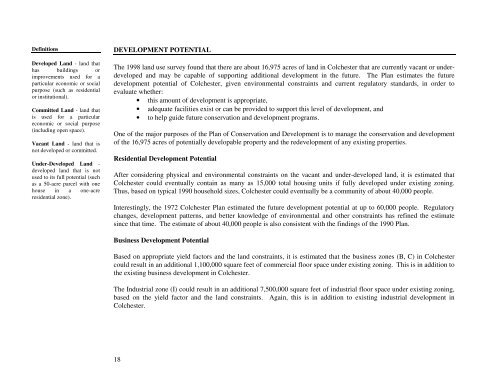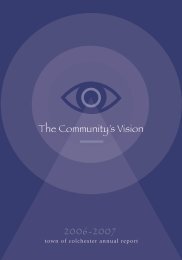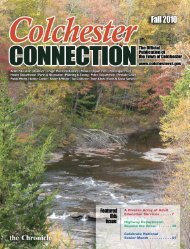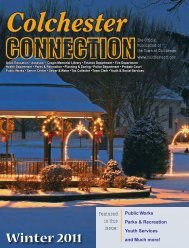2 - Town of Colchester
2 - Town of Colchester
2 - Town of Colchester
- No tags were found...
You also want an ePaper? Increase the reach of your titles
YUMPU automatically turns print PDFs into web optimized ePapers that Google loves.
Definitions<br />
Developed Land - land that<br />
has buildings or<br />
improvements used for a<br />
particular economic or social<br />
purpose (such as residential<br />
or institutional).<br />
Committed Land - land that<br />
is used for a particular<br />
economic or social purpose<br />
(including open space).<br />
Vacant Land - land that is<br />
not developed or committed.<br />
Under-Developed Land -<br />
developed land that is not<br />
used to its full potential (such<br />
as a 50-acre parcel with one<br />
house in a one-acre<br />
residential zone).<br />
DEVELOPMENT POTENTIAL<br />
The 1998 land use survey found that there are about 16,975 acres <strong>of</strong> land in <strong>Colchester</strong> that are currently vacant or underdeveloped<br />
and may be capable <strong>of</strong> supporting additional development in the future. The Plan estimates the future<br />
development potential <strong>of</strong> <strong>Colchester</strong>, given environmental constraints and current regulatory standards, in order to<br />
evaluate whether:<br />
• this amount <strong>of</strong> development is appropriate,<br />
• adequate facilities exist or can be provided to support this level <strong>of</strong> development, and<br />
• to help guide future conservation and development programs.<br />
One <strong>of</strong> the major purposes <strong>of</strong> the Plan <strong>of</strong> Conservation and Development is to manage the conservation and development<br />
<strong>of</strong> the 16,975 acres <strong>of</strong> potentially developable property and the redevelopment <strong>of</strong> any existing properties.<br />
Residential Development Potential<br />
After considering physical and environmental constraints on the vacant and under-developed land, it is estimated that<br />
<strong>Colchester</strong> could eventually contain as many as 15,000 total housing units if fully developed under existing zoning.<br />
Thus, based on typical 1990 household sizes, <strong>Colchester</strong> could eventually be a community <strong>of</strong> about 40,000 people.<br />
Interestingly, the 1972 <strong>Colchester</strong> Plan estimated the future development potential at up to 60,000 people. Regulatory<br />
changes, development patterns, and better knowledge <strong>of</strong> environmental and other constraints has refined the estimate<br />
since that time. The estimate <strong>of</strong> about 40,000 people is also consistent with the findings <strong>of</strong> the 1990 Plan.<br />
Business Development Potential<br />
Based on appropriate yield factors and the land constraints, it is estimated that the business zones (B, C) in <strong>Colchester</strong><br />
could result in an additional 1,100,000 square feet <strong>of</strong> commercial floor space under existing zoning. This is in addition to<br />
the existing business development in <strong>Colchester</strong>.<br />
The Industrial zone (I) could result in an additional 7,500,000 square feet <strong>of</strong> industrial floor space under existing zoning,<br />
based on the yield factor and the land constraints. Again, this is in addition to existing industrial development in<br />
<strong>Colchester</strong>.<br />
18







